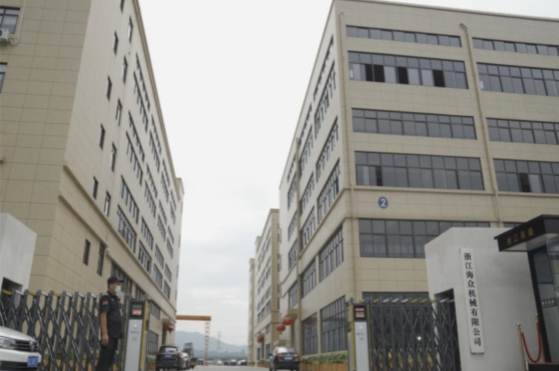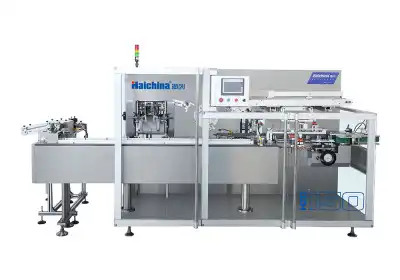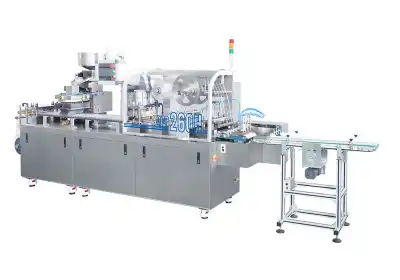The Role of PLC Control in Blister Machine Operations
Enhancing Precision and Consistency
PLC control systems play a pivotal role in ensuring the precision and consistency of blister packaging operations. These sophisticated controllers manage every aspect of the blister forming, filling, and sealing process with remarkable accuracy. By precisely controlling temperature, pressure, and timing, PLCs help maintain uniform blister cavity formation, accurate product placement, and consistent sealing quality. This level of control is particularly crucial when packaging sensitive pharmaceutical products or delicate consumer goods that require stringent environmental conditions.

Streamlining Production Processes
The integration of PLC control in blister machines, especially in an automatic blister packing machine, significantly streamlines production processes. These intelligent systems can coordinate multiple machine functions simultaneously, optimizing the overall packaging workflow. From managing the feeding of raw materials to synchronizing the movement of various machine components, PLCs ensure smooth and efficient operation. This streamlined process leads to higher production rates, reduced downtime, and improved overall equipment effectiveness (OEE). Moreover, PLC-controlled automatic blister packing machines can quickly adapt to different product sizes and packaging requirements, allowing for greater flexibility in production schedules.

Facilitating Real-time Monitoring and Data Collection
One of the key advantages of PLC control in blister machines is the ability to facilitate real-time monitoring and data collection. These systems can track and record various parameters such as machine speed, temperature, pressure, and product count. This wealth of data enables operators to make informed decisions, identify potential issues before they escalate, and implement preventive maintenance strategies. Furthermore, the data collected can be used for quality assurance purposes, regulatory compliance, and continuous process improvement initiatives. The ability to monitor and analyze performance metrics in real-time is invaluable in today's data-driven manufacturing environment.

Advantages of PLC-Controlled Automatic Blister Packing Machines
Increased Operational Efficiency
PLC-controlled automatic blister packing machines offer significant advantages in terms of operational efficiency. These advanced systems can operate at high speeds while maintaining precision and quality, resulting in increased throughput and reduced production costs. The automation provided by PLCs minimizes human intervention, reducing the likelihood of errors and ensuring consistent performance over extended periods. Additionally, PLC-controlled machines can be programmed to optimize energy consumption, further enhancing overall operational efficiency.
Enhanced Flexibility and Customization
Another notable advantage of PLC-controlled blister machines is their enhanced flexibility and customization capabilities. These systems can be easily reprogrammed to accommodate different product sizes, blister designs, and packaging materials. This flexibility allows manufacturers to quickly adapt to changing market demands or introduce new product lines without significant retooling or machine modifications. The ability to store multiple recipe settings in the PLC memory enables rapid changeovers between different products, minimizing downtime and maximizing production capacity.
Improved Safety and Compliance
PLC control systems contribute significantly to improved safety and regulatory compliance in blister packaging operations. These intelligent controllers can implement various safety interlocks and emergency stop functions, protecting both operators and equipment. PLCs can also ensure that critical process parameters remain within specified limits, helping manufacturers comply with Good Manufacturing Practice (GMP) guidelines and other industry regulations. Moreover, the detailed data logging capabilities of PLC-controlled machines provide a robust audit trail, which is essential for meeting quality assurance and traceability requirements in industries such as pharmaceuticals and medical devices.
Future Trends in PLC-Controlled Blister Packaging Technology
Integration with Industry 4.0 and IoT
The future of PLC-controlled blister packaging technology is closely tied to the ongoing Industry 4.0 revolution and the Internet of Things (IoT). As manufacturing processes become increasingly interconnected and data-driven, PLC systems in blister machines are evolving to support greater connectivity and data exchange. This integration allows for remote monitoring, predictive maintenance, and advanced analytics capabilities. By leveraging cloud computing and big data technologies, manufacturers can gain deeper insights into their packaging operations, optimize performance, and make data-driven decisions in real-time.
Advancements in Machine Learning and AI
Machine learning and artificial intelligence (AI) are set to play an increasingly important role in PLC-controlled automatic blister packing machine systems. These advanced technologies can enhance the decision-making capabilities of PLC systems, enabling more intelligent and adaptive control of packaging processes. For instance, AI algorithms could analyze historical data to predict and prevent potential quality issues or optimize machine parameters for different products automatically. As these technologies mature, we can expect to see blister machines that are not only automated but also capable of self-optimization and continuous improvement.
Enhanced Human-Machine Interfaces
The evolution of human-machine interfaces (HMIs) is another significant trend in PLC-controlled blister packaging technology. Modern HMIs are becoming more intuitive, user-friendly, and feature-rich, allowing operators to interact with machines more efficiently. Touchscreen displays, augmented reality (AR) interfaces, and mobile device integration are some of the innovations enhancing operator control and monitoring capabilities. These advanced interfaces not only improve operational efficiency but also contribute to reduced training times and increased operator satisfaction. As HMI technology continues to advance, we can anticipate even more sophisticated and user-centric control interfaces for blister packaging machines.
Conclusion
PLC control has become an indispensable component of modern blister machines, driving efficiency, precision, and flexibility in packaging operations. From enhancing operational consistency to enabling advanced monitoring and data collection, PLC-controlled systems offer numerous benefits that are essential in today's competitive manufacturing landscape. As technology continues to evolve, the integration of PLC control with Industry 4.0 principles, AI, and advanced user interfaces will further revolutionize blister packaging processes. Manufacturers looking to stay ahead in the packaging industry must embrace these technological advancements to meet the growing demands for quality, efficiency, and adaptability in blister packaging operations.
Contact Us
To learn more about our advanced PLC-controlled automatic blister packing machines and how they can benefit your packaging operations, please contact us at [email protected]. Our team of experts is ready to help you find the perfect packaging solution for your specific needs.





